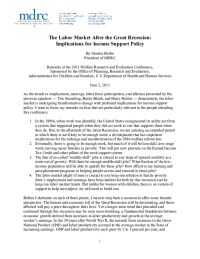The Labor Market After the Great Recession
Implications for Income Support Policy
Remarks given at the 2011 Welfare Research and Evaluation Conference, sponsored by the Office of Planning, Research and Evaluation, Administration for Children and Families, U.S. Department of Health and Human Services
As the trends in employment, earnings, labor force participation, and idleness presented by the previous speakers — Tim Smeeding, Becky Blank, and Harry Holzer — demonstrate, the labor market is undergoing transformative change with profound implications for income support policy. I want to focus my remarks on four that are particularly relevant to the people attending this conference:
- In the 1990s, when work was plentiful, the United States reengineered its safety net from a system that supported people when they did not work to one that supports them when they do. But, in the aftermath of the Great Recession, we are entering an extended period in which there is not likely to be enough work, a development that has important implications for the redesign and reauthorization of the 1996 welfare reform law.
- Eventually, there is going to be enough work, but much of it will be low-skill, low-wage work, leaving many families in poverty. This will put new pressure on the Earned Income Tax Credit and other pillars of the work support system.
- The fate of so-called “middle-skill” jobs is critical to any hope of upward mobility as a route out of poverty: Will there be enough middle-skill jobs? What fraction of the low-income population will be able to qualify for these jobs? How effective are training and post-placement programs in helping people access and succeed in these jobs?
- The labor market plight of men is crucial to any long-run solution to family poverty. Men’s employment and earnings have been hardest hit both by this recession and by long-run labor market trends. But unlike for women with children, there is no system of support to help men adjust; we will need to build one.
Before I elaborate on each of these points, I want to step back a moment to offer some broader perspective. The human and economic toll of the Great Recession will be devastating, and those affected will pay a price throughout their lives. Yet a longer-term trend that preceded and continued through this recession may be even more troubling: a fundamental breakdown between economic growth derived from increases in labor productivity and growth in the average worker’s earnings. In the 30 years after World War II, the rewards from increases in the Gross National Product (GNP) and labor productivity accrued to the average worker in the form of increasing earnings. GNP and labor productivity each grew by 2 to 3 percent per year, and average wages and earnings followed suit. It was as if the entire nation was on an up-escalator. That escalator stopped in the mid-1970s for workers. Economic growth and labor productivity growth continued upward — but not workers’ earnings.






